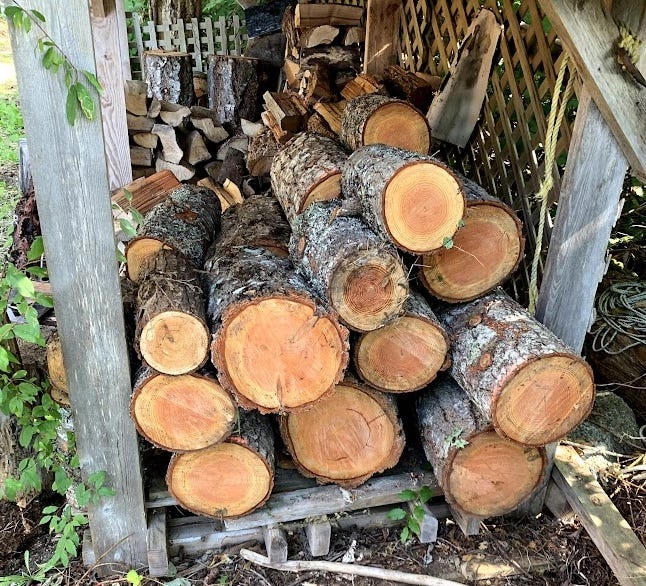You put your name on every job you do
$20 to stack a cord of wood. What is culture? Starting to define Slack culture in stories.
One day, later in 2013 as we started building up the team, Stewart told a story over lunch about his dad, and growing up and learning about reputation and pride in doing good work.
Stewart’s family lived with fewer than a thousand people in a small town called Lund, 171 kilometres north of Vancouver. Highway 101 runs the length of the Pacific coast, connected by bridges and ferries, crossing two borders from Mexico to Canada, through the U.S., and Lund was the northern end of that road. The start or end of the connection, depending on your perspective.
Stewart’s dad had come north to Lund during the Vietnam war years. The family used wood to heat their home in the wet wintry months. In the fall, 11-year-old Stewart’s dad had made him an offer: for $20, would he stack all the wood for the winter season?
The way Stewart told the story, he was thrilled to do the job. $20 was a lot of money to a kid at the time, in the early 1980s, when candy and comic books occupied the spending imagination. They had a single store in town. He knew its inventory well. Of course he would.
A truck delivered the split wood on the appointed day. “Do you know how much a cord of wood is?” Stewart asked us. We had a rough idea. “It was a dump truck. It was a shit load of wood,” he said.
“I started in the morning. By around 11 I was tired and told my dad I was done. He came to look at the stack and I could see he was disappointed. Logs were all over, maybe some stacked, some laying in piles. It was a lousy job. He told me, ‘You put your name on every job you do. Is this the job you want to put your name on?’”
Young Stewart did not want his name on the lousy job he’d done.
So he went back to work and eventually got the whole cord of wood stacked. A big job for anyone, never mind an 11-year-old.
(For reference, that cord would be 4’ x 8’ x 4’ cubed of stacked wood, a plywood sheet of wood, 4-feet high.)
What is culture?
I remember Stewart telling that story as important. He was telling us how he thought about doing a good job. He was maybe also telling us what he wanted it to mean for us to do a good job at Slack. And he was telling us how he would evaluate us for our work. Our name would be on every job we did.
For me, the story did a lot of work building our culture — what it meant to work at Slack. Or, put another way, it showed how, “People like us do things like this,” as Seth Godin describes culture.
Years later Slack would codify its culture in a few revisions, first as Attributes, later as Values. Craftsmanship was one of the words that persisted as important to us, one of those Attributes, then Values.
The story we used to illustrate Craftsmanship was that when you were building a chest of drawers, did you choose to paint the back of the drawers? That was the standard of Craftsmanship we sought to achieve. Maybe no one would ever see the back of the drawer, but we would know it was finished and met our standard.
That story of painting the back of the drawer was good and illustrative. But the story that actually stuck with me more was always the one Stewart told about the cord of wood, and the lesson was closer to home: you put your name on every job you do.
Did that lesson make life or work at Slack easier? Nope.
I found that many times it actually made work at Slack harder. Many days I just wanted something done so I could move on.
Yet I still find myself internally saying “You put your name on every job you do” as encouragement to find energy if I’m flagging, or as a reminder to do a thing to a standard I’d be proud to see tagged with my name.
Putting your name on a job set a standard, and once the standard had been set, we had to strive for it. It conveyed the value of conscientiousness and accountability for a task and showed us what people like us valued.
So, thanks, Stewart. Your voice is still in my head.
Coda
At the time I’m describing above, we were still a very small team, maybe 12 or 15 people. Growth was coming, but we didn’t necessarily see its approach.
The success of our preview release hinted at our future, but I remember being pretty blissfully unaware of what that level of interest could mean. We came to work, did our jobs, and went home. There was always too much to do and each day it just washed over you.
When Stewart told us the story of stacking the cord of wood, I think he may have known clearer than the rest of us what was coming. Perhaps it was his way of making sense of the moment and trying to direct the company and its decisions as it outgrew his direct oversight. Maybe.
In any case, we loved it. We wanted to be conscientious and accountable. That would be Slack. We would try to put our name on every job we did.
Up next:
Learning from the first 1,000 Slack invites
Below is a document from a time machine. In September, 2013, I wrote and shared the document with the Slack team to summarize what I thought we’d learned up to then. It appears almost entirely verbatim and was titled 1,000 Slack Invites.






I enjoyed this post, and the shorter format focused on a story/idea.